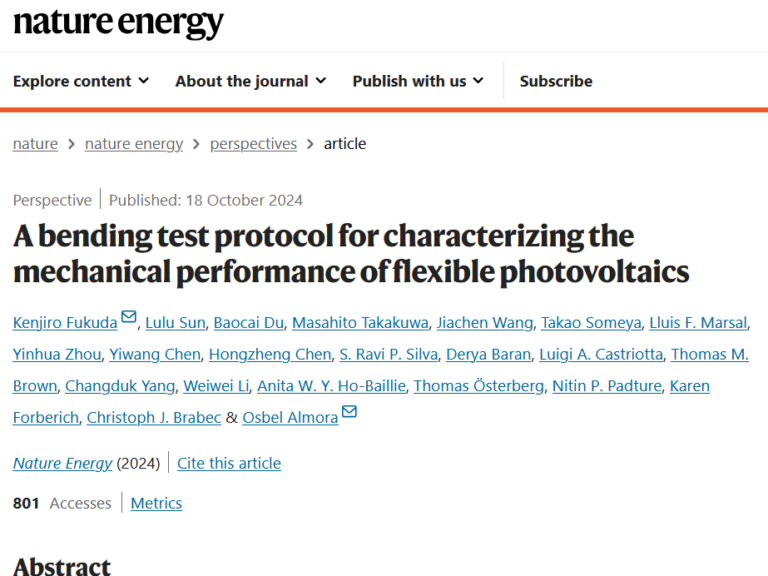Flexible and lightweight PV devices are becoming an essential direction in photovoltaics. Driven by the progress in organic and perovskite PV, promising application fields such as wearable, portable, indoor, and internet-of-things are coming into sight. We have started to report on flexible PV devices in our emerging PV reports, but noticed rather soon that there are no consistent criteria for defining flexibility in the context of photovoltaics. This was quite a discrepancy given the rapid performance progress, with flexible emerging PV reaching efficiencies (PCE) beyond 24%.
This is why Kenjiro and Osbel took the leadership to develop a broadly accepted testing protocol to report PV performance as a function of bending stress, which was just reported in Nature Energy. To account for the different architectures, materials, substrate, and packaging thicknesses, the protocol proposes measuring PCE over 1,000 bending cycles under 1% strain. In the manuscript, we analyzed the flexible performance of state-of-the-art devices and showed that reporting bending stress is the most relevant parameter, as it allows for comparison of tests on different cells/modules under different bending radii. The guidelines provide recommendations related to bending, highlight the relevance of packaging, and clarify bending tests and bending test conditions, including testing parallel and perpendicular orientations of the bending axis relative to module interconnects and electric current directions.
The article is already available on Nature Energy:
Kenjiro Fukuda, Lulu Sun, Baocai Du, Masahito Takakuwa, Jiachen Wang, Takao Someya, Lluis F. Marsal, Yinhua Zhou, Yiwang Chen, Hongzheng Chen, S. Ravi P. Silva, Derya Baran, Luigi A. Castriotta, Thomas M. Brown, Changduk Yang, Weiwei Li, Anita W. Y. Ho-Baillie, Thomas Österberg, Nitin P. Padture, Karen Forberich, Christoph J. Brabec & Osbel Almora. Coherent growth of high-Miller-index facets enhances perovskite solar cells. Nature (2024).
https://doi.org/10.1038/s41586-024-08159-5

Flexible and lightweight PV devices are becoming an essential direction in photovoltaics. Driven by the progress in organic and perovskite PV, promising application fields such as wearable, portable, indoor, and internet-of-things are coming into sight. We have started to report on flexible PV devices in our emerging PV reports, but noticed rather soon that there are no consistent criteria for defining flexibility in the context of photovoltaics. This was quite a discrepancy given the rapid performance progress, with flexible emerging PV reaching efficiencies (PCE) beyond 24%.
This is why Kenjiro and Osbel took the leadership to develop a broadly accepted testing protocol to report PV performance as a function of bending stress, which was just reported in Nature Energy. To account for the different architectures, materials, substrate, and packaging thicknesses, the protocol proposes measuring PCE over 1,000 bending cycles under 1% strain. In the manuscript, we analyzed the flexible performance of state-of-the-art devices and showed that reporting bending stress is the most relevant parameter, as it allows for comparison of tests on different cells/modules under different bending radii. The guidelines provide recommendations related to bending, highlight the relevance of packaging, and clarify bending tests and bending test conditions, including testing parallel and perpendicular orientations of the bending axis relative to module interconnects and electric current directions.
The article is already available on Nature Energy:
Kenjiro Fukuda, Lulu Sun, Baocai Du, Masahito Takakuwa, Jiachen Wang, Takao Someya, Lluis F. Marsal, Yinhua Zhou, Yiwang Chen, Hongzheng Chen, S. Ravi P. Silva, Derya Baran, Luigi A. Castriotta, Thomas M. Brown, Changduk Yang, Weiwei Li, Anita W. Y. Ho-Baillie, Thomas Österberg, Nitin P. Padture, Karen Forberich, Christoph J. Brabec & Osbel Almora. Coherent growth of high-Miller-index facets enhances perovskite solar cells. Nature (2024).
https://doi.org/10.1038/s41586-024-08159-5